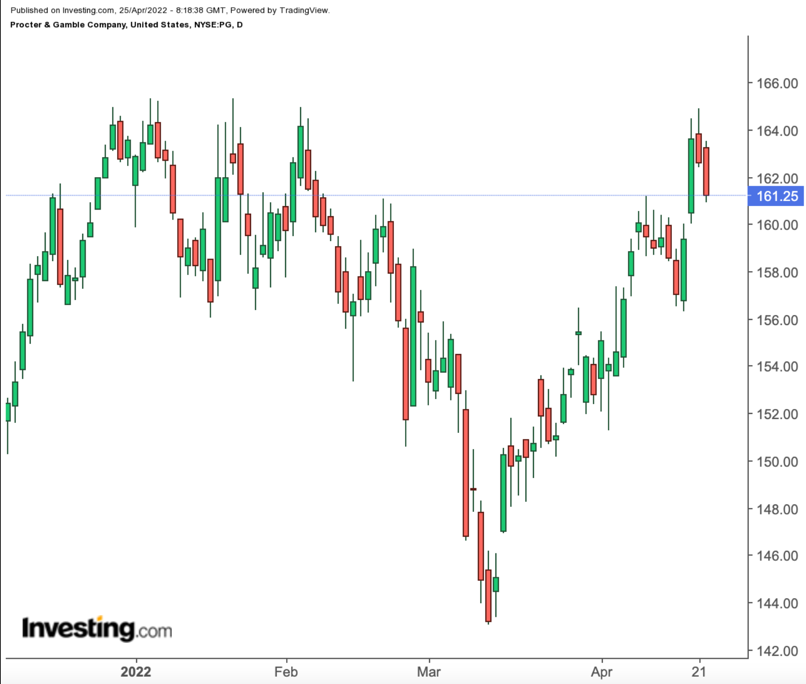Turning around a company like Procter & Gamble (NYSE:PG) is like turning around a battleship. The performance of the consumer staples giant over the past decade proves the truth of that aphorism.

Procter & Gamble has turned itself around but hasn't done so quickly—or easily. A process that started in 2012 took years to bear fruit. The shares closed at $161.25 on Friday.
When it did, P&G finally got back to being the powerhouse it had been in the past. And PG stock turned from being a laggard to a leader. It pays a significant dividend, distributing $3.65 per share annual dividend for a yield of 2.33%.
However, the problem at the moment, precisely, is that the turnaround is complete. There's little, if anything, left in the way of operational improvements or cost-cutting. Yet, PG stock is trading at historic highs, highs which seem to price in a continuation of the admittedly impressive growth over the past few years.
That outlook appears far too optimistic. Significant challenges loom. Broad market trading has become increasingly volatile.
Some investors are, no doubt, looking to PG stock as a place to hide from that volatility—but there's a good chance those investors will wind up disappointed.
The Turnaround Finally Hits
It took time and effort for the P&G turnaround to work. It began in 2012 with a $10 billion cost-cutting program announced by then chief executive officer, Bob McDonald. Revenue growth stayed low, however, and P&G struggled to increase its earnings and dividend.
McDonald was pushed out the following year, and P&G decided to shrink. The company sold many of its beauty brands to Coty (NYSE:COTY) and divested battery maker Duracell to Berkshire Hathaway (NYSE:BRKa). Under CEO David Taylor, P&G cut down to 10 categories from 15, ostensibly shrinking decision-making and creating a more nimble structure for a business that had gone a decade without creating a billion-dollar brand.
That plan didn't work, either—at least not immediately. From fiscal 2015 to fiscal 2018 (P&G fiscal years end in June), revenue growth for the remaining brands averaged barely over 1%. P&G's dividend had grown at a double-digit clip before the financial crisis; it was increased just 1% in 2016 and 3% in the years immediately before and after.
By mid-2018, PG stock had been dead money for about five years. Peers like Kimberly-Clark (NYSE:KMB) and Unilever (NYSE:UL) looked far more attractive. But from that point on, both the P&G business and P&G stock took off.
Organic revenue growth totaled about 5% from FY15 to FY18; guidance for FY22 suggests it will average above 5% over the following four years. Earnings per share increased more than 10% in each of the last two fiscal years. A 10% dividend hike in early 2021 was the largest since 2009.
P&G has taken market share, launched new products, and improved its competitive positioning overseas (notably in China). As a result, the same stock that lagged peers began to crush the market: PG stock has gained 121% over the past four years and 146% including dividends.
Valuation Concerns Arise
The worry at the moment, however, is that the four-year rally has left PG stock looking rather expensive. Shares trade at about 27x guided adjusted EPS for FY22—which appears to be the highest multiple PG stock has received since at least 2005. The 2.18% dividend yield is the lowest since 2009.
Meanwhile, growth this year should slow across the board. P&G is guiding for organic revenue to grow between 4% and 5%. But all of those gains are coming from pricing; the volume of items sold is expected to be flat. Adjusted EPS (what P&G calls “Core EPS”) should increase just 3%; Core net income should be roughly flat, given an expected lower share count.
27x earnings for essentially zero profit growth quite obviously is not an attractive fundamental combination. Even the dividend yield looks far less attractive now that the 10-year Treasury bond is heading toward 3%.
The PG stock chart seems to highlight valuation worries as well, with the stock repeatedly stalling out at the $165 level going back to late December—and doing so again last week.
There's no doubt that this is a great business. But it's priced as such—to say the least. And investors who think that simply owning a great business is a way to avoid market volatility need only to look at PG stock in the past. Even when the company was performing well in 2008-2009—and, again, raising its dividend 10% annually—the stock still dropped by more than one-third from the beginning of 2008 to March 2009 lows.
Taking The Broader View
To be fair, the valuation worries cited here are perhaps a bit misleading. It's true that P&G's earnings growth is going to be rather modest in FY22. But, as the company pointed out on its post-earnings conference call last week, the problem is higher costs. Chief financial officer Andre Schulten said on the call that higher prices for commodities and freight, plus foreign exchange effects, would total a $3.2 billion headwind for the company this fiscal year.
That figure is after-tax, and works out to about $1.26 per share—more than 20% of the guided core EPS of about $5.85. Some of that pressure is being offset by higher pricing—but not all of it.
So, the underlying business is performing better than EPS guidance might suggest. Total profit won't be flat year-over-year because P&G isn't selling enough; it will be flat year-over-year because inflation has spiked worldwide. In fact, as Schulten pointed out, since the fiscal year began, P&G has raised its estimate of these impacts by 56 cents. Yet, guidance has stayed intact. Excluding those external pressures, the business is performing better than even the company expected it would nine months ago.
The problem, however, is that those pressures don't seem likely to change any time soon. There's no sign commodity pressures are going to ease. Labor and freight inflation remain elevated.
The stronger dollar is perhaps the biggest issue. One of the big problems for P&G last decade was a sharp rise in the dollar. A stronger dollar means that international revenue—56% of last year's total sales—is less profitable, since local currency sales turn into fewer US dollars. That problem is only amplified by the fact that rivals in those countries can undercut P&G on pricing, since they don't face currency pressures at all.
The same Federal Reserve rate hikes driving the 10-year yield higher are likely to strengthen the dollar, since they increase potential returns in dollars on capital from around the world.
To be sure, P&G isn't likely to face another $3 billion-plus in headwinds in FY23. Nor is a stronger dollar alone likely to send the company and the stock back to the dark days of 2015-2018.
But those downside scenarios aren't what is priced in at 27x earnings. Continued growth is. And as well as P&G has performed over the past few years—and even in the most recent quarter—there are an awful lot of stumbling blocks to that growth going forward. Nervous investors are unlikely to ignore those challenges, which means a falling broad market is likely to bring PG stock down with it.
Disclaimer: As of this writing, Vince Martin has no positions in any securities mentioned.
